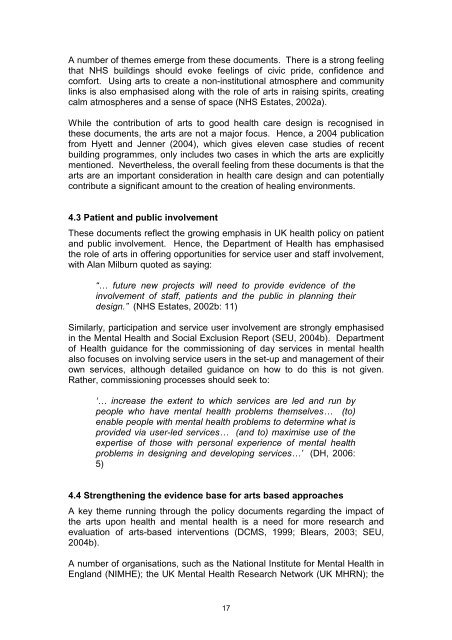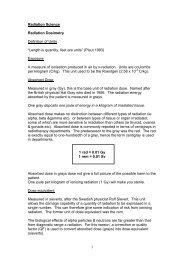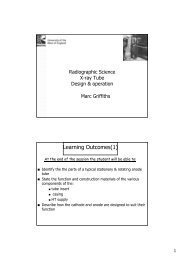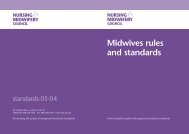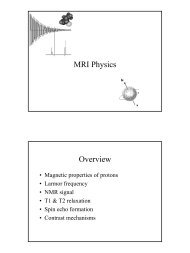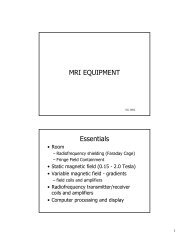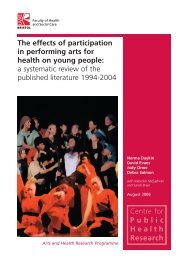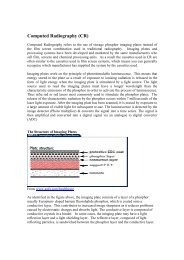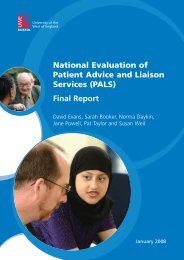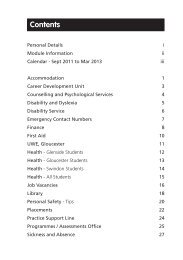Support for <strong>the</strong> role <strong>of</strong> arts in health care has been reinforced more recently,for example by Hazel Blears MP in a speech in February 2003 discussinglarge-scale capital investment in <strong>the</strong> arts (Blears, 2003). Blears linkedinvestment in <strong>the</strong> arts to wider regeneration and investment, using The LowryArt Gallery in Manchester as an example <strong>of</strong> how arts projects can contributeto local investment and employment as well as community engagement. Shealso suggested that fur<strong>the</strong>r research was needed to identify benefits and risks<strong>of</strong> arts interventions in order to ensure best use <strong>of</strong> future opportunities forinvestment.While links between mental ill health and social exclusion have beenemphasised in a number <strong>of</strong> policy documents, <strong>the</strong> role <strong>of</strong> arts has onlyrecently been discussed in any depth (DH, 1998; SEU, 2004a; SEU, 2004b).Hence, in <strong>the</strong> 1998 document, Modernising Mental Health Services (DH,1998), <strong>the</strong> government’s plans for <strong>the</strong> development <strong>of</strong> mental health serviceswere set out. There was a clear focus upon tackling <strong>the</strong> causes <strong>of</strong> mental illhealth, including social exclusion, although <strong>the</strong> role <strong>of</strong> arts-based interventionswas not discussed directly. The emphasis was on medical treatment as wellas reducing social exclusion in key areas such as crime, employment andeducation.More recently <strong>the</strong> role <strong>of</strong> arts, alongside leisure and sport, has beenrecognised in terms <strong>of</strong> community participation and <strong>the</strong>rapeutic benefit.However, it is also suggested that more research into <strong>the</strong> effectiveness <strong>of</strong> artbasedinterventions is needed (SEU, 2004b).4.2 The impact <strong>of</strong> physical environments and building design on patientoutcomesThe Estates and Facilities Division <strong>of</strong> <strong>the</strong> Department <strong>of</strong> Health is a keyorganisation that has increasingly recognised <strong>the</strong> impact <strong>of</strong> <strong>the</strong> physicalenvironment on health. On <strong>the</strong> DH website, its role is described as:‘Strategic development <strong>of</strong> a flexible and responsive environmentfor health and social care, delivering improved health outcomesthrough innovative estates and facilities solutions which enablehigh quality, safe patient care.’ (NHS Estates and facilitiesmanagement 16/01/06)Much <strong>of</strong> <strong>the</strong> advice <strong>of</strong>fered by The Estates and Facilities Division <strong>of</strong> <strong>the</strong>Department <strong>of</strong> Health centres on issues such as safety, maintenance, energyefficiency and environmental awareness. However, <strong>the</strong>re is a clearassumption that <strong>the</strong> hospital environment can have an impact on <strong>the</strong> moraleand well-being <strong>of</strong> service users, staff and visitors. The role <strong>of</strong> <strong>the</strong> arts isdiscussed in a series <strong>of</strong> publications providing guidance for <strong>the</strong> development<strong>of</strong> building projects (NHS Estates, 2002a; NHS Estates, 2002b; NHS Estates,2003a; NHS Estates, 2003b).16
A number <strong>of</strong> <strong>the</strong>mes emerge from <strong>the</strong>se documents. There is a strong feelingthat NHS buildings should evoke feelings <strong>of</strong> civic pride, confidence andcomfort. Using arts to create a non-institutional atmosphere and communitylinks is also emphasised along with <strong>the</strong> role <strong>of</strong> arts in raising spirits, creatingcalm atmospheres and a sense <strong>of</strong> space (NHS Estates, 2002a).While <strong>the</strong> contribution <strong>of</strong> arts to good health care design is recognised in<strong>the</strong>se documents, <strong>the</strong> arts are not a major focus. Hence, a 2004 publicationfrom Hyett and Jenner (2004), which gives eleven case studies <strong>of</strong> recentbuilding programmes, only includes two cases in which <strong>the</strong> arts are explicitlymentioned. Never<strong>the</strong>less, <strong>the</strong> overall feeling from <strong>the</strong>se documents is that <strong>the</strong>arts are an important consideration in health care design and can potentiallycontribute a significant amount to <strong>the</strong> creation <strong>of</strong> healing environments.4.3 Patient and public involvementThese documents reflect <strong>the</strong> growing emphasis in UK health policy on patientand public involvement. Hence, <strong>the</strong> Department <strong>of</strong> Health has emphasised<strong>the</strong> role <strong>of</strong> arts in <strong>of</strong>fering opportunities for service user and staff involvement,with Alan Milburn quoted as saying:“… future new projects will need to provide evidence <strong>of</strong> <strong>the</strong>involvement <strong>of</strong> staff, patients and <strong>the</strong> public in planning <strong>the</strong>irdesign.” (NHS Estates, 2002b: 11)Similarly, participation and service user involvement are strongly emphasisedin <strong>the</strong> Mental Health and Social Exclusion Report (SEU, 2004b). Department<strong>of</strong> Health guidance for <strong>the</strong> commissioning <strong>of</strong> day services in mental healthalso focuses on involving service users in <strong>the</strong> set-up and management <strong>of</strong> <strong>the</strong>irown services, although detailed guidance on how to do this is not given.Ra<strong>the</strong>r, commissioning processes should seek to:‘… increase <strong>the</strong> extent to which services are led and run bypeople who have mental health problems <strong>the</strong>mselves… (to)enable people with mental health problems to determine what isprovided via user-led services… (and to) maximise use <strong>of</strong> <strong>the</strong>expertise <strong>of</strong> those with personal experience <strong>of</strong> mental healthproblems in designing and developing services…’ (DH, 2006:5)4.4 Streng<strong>the</strong>ning <strong>the</strong> evidence base for arts based approachesA key <strong>the</strong>me running through <strong>the</strong> policy documents regarding <strong>the</strong> impact <strong>of</strong><strong>the</strong> arts upon health and mental health is a need for more research andevaluation <strong>of</strong> arts-based interventions (DCMS, 1999; Blears, 2003; SEU,2004b).A number <strong>of</strong> organisations, such as <strong>the</strong> National Institute for Mental Health in<strong>England</strong> (NIMHE); <strong>the</strong> UK Mental Health Research Network (UK MHRN); <strong>the</strong>17
- Page 1: The impact of visual artsand design
- Page 5 and 6: Table of ContentsExecutive Summary.
- Page 7 and 8: 10. Results of Non-intervention Stu
- Page 9 and 10: Executive Summary(i)(ii)(iii)This r
- Page 11: are unlikely to receive consensual
- Page 15 and 16: 2. Systematic Review Methodology an
- Page 17 and 18: 3. Overview of Contextual Literatur
- Page 19 and 20: Notions of appropriate and inapprop
- Page 21: Identifying these different dimensi
- Page 26 and 27: Arts Council England; the recently
- Page 28 and 29: consequent difficulty of relating a
- Page 30 and 31: outcomes including depression, elev
- Page 32 and 33: Inappropriate art can worsen patien
- Page 34 and 35: outcomes are also addressed, althou
- Page 37 and 38: 6. Methodological Characteristics o
- Page 39 and 40: General issuesThe research on the i
- Page 41 and 42: was an opinion survey or 2200 staff
- Page 43: There are several non-experimental
- Page 46 and 47: Another study by Duncan (2003) used
- Page 48 and 49: The research also suggests a number
- Page 50 and 51: wards and three female wards, inclu
- Page 52 and 53: the new wards did not allow patient
- Page 54 and 55: Patients with stressful conditions,
- Page 56 and 57: The author suggests that participat
- Page 58 and 59: and Douglas, 2005). Qualitative met
- Page 60 and 61: health care environment, issues als
- Page 62 and 63: Creating uplifting environments and
- Page 64 and 65: esearch. Critical appraisal of the
- Page 66 and 67: Coultier, A.C. (2005) What is the e
- Page 68 and 69: McAuslane, L. and Sperlinger, D. (1
- Page 70 and 71: Ulrich, R. (1992) How design impact
- Page 72 and 73: Appendix 2. Search terms used in th
- Page 74 and 75:
Appendix 4. Overview of the search
- Page 76 and 77:
Appendix 6: Data Extraction SheetSt
- Page 78 and 79:
Staricoffand Loppert(2003)(unrepres
- Page 80 and 81:
Passini etal. (1998)Schofield(2003)
- Page 82 and 83:
Appendix 9. Overview of studies of
- Page 84 and 85:
BenjaminandSpector(1990)Assessment
- Page 86 and 87:
y Bryan Lawson and Michael Phiri, i


